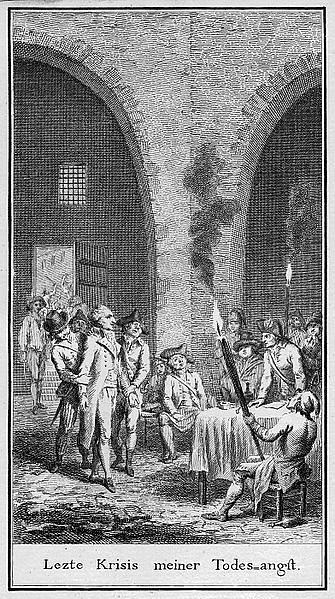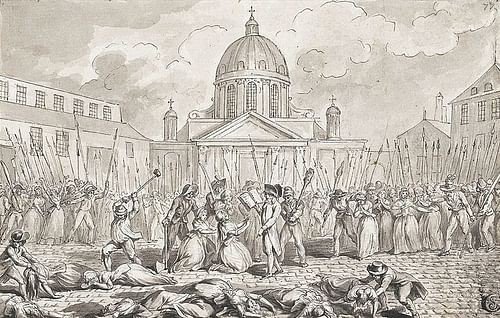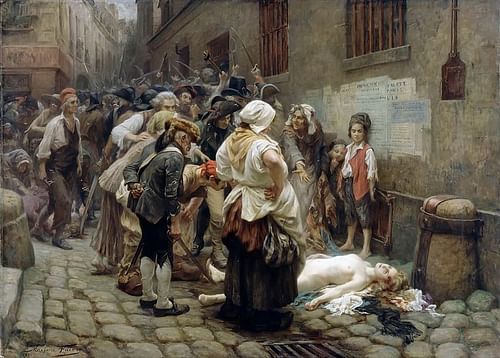
The September Massacres refers to a series of mass killings that took place in the prisons of Paris between 2 and 7 September 1792, during the French Revolution (1789-99). Sometimes known as the first Terror, the massacres saw between 1,100 and 1,400 prisoners murdered by gangs of sans-culottes, driven by a fear that the prisoners would rebel and destroy Paris.
French military failures in the opening months of the War of the First Coalition (1792-97) had left the path to Paris open to a Prussian army, which promised the city's complete destruction. Panicking, mobs of Parisians rushed to the city's prisons, where royalists and refractory priests were being held on questionable counter-revolutionary charges. Taking justice upon themselves, the mobs set up mock tribunals in which they passed sentences on the 'traitors' and executed many on the spot. The September Massacres are significant for ushering in a new phase of the Revolution, one in which terror and violence were considered legitimate political tools. This, of course, would lead directly to the bloodletting of the Reign of Terror, which began about a year later.
Threats Against a Kingless France
On the morning of 13 August 1792, the sun rose over a new, kingless France. Time and again, King Louis XVI of France had chafed against the new limitations imposed on him by the constitution and had shown signs of treacherous, counter-revolutionary intentions. A final attempt by the sans-culottes, or revolutionary lower classes, of Paris to reconcile him with the Revolution in the Demonstration of 20 June 1792 had failed. When they came again on 10 August, it was not to convince the king to adhere to a revolutionary agenda, but to depose him.
The Storming of the Tuileries Palace resulted in a bloody battle between thousands of Parisian rebels and the king's loyal Swiss Guard; when the Swiss finally gave in and began to retreat, the battle became a massacre. At the end of the day, over 800 people were dead, and the city was firmly in the hands of a new municipal government calling itself the Insurrectionary Commune. At the Commune's insistence, a National Convention was summoned to draft a new constitution. In the meantime, the king's powers were suspended, and he and his family were imprisoned in the prison fortress known as the Temple. It would be over a month before a republic would officially be declared, but for all intents and purposes, the thousand-year-old French monarchy was finally abolished.
Though the monarchy was effectively over, France's problems were not. An invading army of Prussians, Austrians, and royalist French émigrés was making its way toward Paris, scattering what feeble resistance lay before it. On 25 July, the invading army's commander, the Duke of Brunswick, issued the Brunswick Manifesto, which promised Paris' total destruction should any harm come to the French royal family. Now, after the Parisians had crossed a Rubicon with their attack on the Tuileries, it appeared that Brunswick was prepared to make good on his threat. On 19 August, the Prussian-led force crossed the frontier into France and took the fortress of Longwy four days later. On 30 August, it laid siege to the critical fortress of Verdun. Should this fortress fall, the road to Paris would lay wide open through the Marne Valley.
Paris was understandably alarmed by the invaders' swift progress. The spattering of fighting that had occurred the previous spring had lulled many into a false sense of security, believing that the war would be fought in the fields of Belgium. Now that it had come to their own backyard, it was time to panic. For the second time in a month, the Legislative Assembly declared the patrie (fatherland) to be in danger, and whispers abounded of terrible crimes the Prussians were committing on their march through France, such as the mutilation of peasant women for sport and the senseless bayoneting of children. Though these tales were nothing more than conjecture, fueled by the paranoia of military invasion, they forced Parisians to think about the Brunswick Manifesto and to imagine the dreadful fate that awaited them when Prussian flags waved in their streets.
Luckily, the city bristled with armed men. Tens of thousands of National Guardsmen, now under the command of the sans-culotte leader Antoine Santerre, stood by, as did 20,000 provincial militiamen known as fédérés. In response to the fall of Longwy, Georges Danton, the new minister of justice, called for 30,000 volunteers to leave the capital and join the army. Yet, as patriotic as many Parisians were, they were reluctant to leave the city, fearing that an absence of armed men would lead to a counter-revolutionary rebellion within Paris itself. Such a rebellion, they believed, would begin in the prisons, which were bursting with royalists and priests considered hostile to the patrie.
Prisoners of Paris
Paris' prisons began to fill shortly after the Storming of the Tuileries, as the new Insurrectionary Commune began to mete out justice to the nation's enemies. The arrests began with members of the Swiss Guard who had somehow managed to survive the frenzied slaughter of their comrades on 10 August. Then, the refractory priests who had failed to swear oaths of loyalty to France were taken into custody, seized from their seminaries and churches. The arrests only ramped up from there, as the Commune detained those suspected of royalist sympathies, including citizens who had been heard grumbling about the recent insurrections or voiced support for General Lafayette's attempted coup.
The Insurrectionists shut down the royal press and had its editors and printers arrested, and even apprehended former royal servants and members of the court; the most notable of the royal arrests was Princess de Lamballe, Marie Antoinette's close friend and lady-in-waiting. In the last two weeks of August, the Insurrectionary Commune arrested over a thousand people, many on flimsy charges. Truly, it was a paranoia-fueled roundup of the sort that would become all too familiar in the coming Reign of Terror. But the similarities between August 1792 and the Terror did not stop with arrests.
On 21 August, a newfangled execution device ominously referred to as 'the machine' was used to behead Louis Collot d'Angremont, the secretary of the administration of the National Guard accused of partaking in a royalist conspiracy. This device, the guillotine, had been introduced earlier that year when it was used to execute a violent highwayman. Now, for the first time, it was used to execute supposed enemies of the Revolution. A special tribunal was established to pass the sentences, which it did on behalf of the Insurrectionary Commune rather than the Legislative Assembly. Such sentences could not be appealed. Two more counter-revolutionaries, a royalist journalist and one of the king's former intendants, were also given to the guillotine.
The Insurrectionary Commune turned Paris into something of a police state. On Danton's orders, bands of armed sans-culottes visited the homes of Parisians in the early morning hours of 30 and 31 August. These 'domiciliary visits' were ostensibly made to requisition personal firearms for the use of the nation; in reality, Danton's men searched for hidden suspects or incriminating documents. Thousands more Parisians were arrested, filling Paris' prisons with suspected traitors.
This was the last straw for the Legislative Assembly, which, despite being the nation's legislating body, had been playing second fiddle to the Commune ever since 10 August. It demanded the immediate dissolution of the Commune and called for new municipal elections to be held. But this move outraged the sans-culottes, who saw the Commune as the true saviors of France. The Commune not only refused to disband but, at the instigation of Maximilien Robespierre, even attempted to arrest members of the Assembly itself. It was only the intervention of Danton himself that prevented the arrests of leading Assembly deputies such as Jacques-Pierre Brissot. Danton's act of benevolence toward his revolutionary colleagues probably saved their lives.
Tensions Rise
On 11 August, the new commander of the National Guard, Santerre, received a note from the Paris police warning that "a plan is being formed to invade the prisons of Paris in order to remove all the prisoners and to exact summary justice on them" (Davidson, 112). Santerre did not act. Later, the provocative journalist Jean-Paul Marat urged all good citizens to "go to the [prison of] Abbaye, seize priests and especially the officers of the Swiss guards and their accomplices and run a sword through them" (Schama, 630). Marat's defenders would later claim he had been speaking in metaphor, although there is no reason for his readers to have interpreted it any way other than literally. Perhaps the most chilling call to action was made by Danton's friend, playwright Fabre d'Eglantine:
Once more, citizens, to arms! May all France bristle with pikes, bayonets, cannon, and daggers, so that everyone shall be a soldier; let us clear the ranks of these vile slaves of tyranny. In the towns let the blood of traitors be the first holocaust to Liberty, so that in advancing to meet the common enemy, we leave nothing behind to disquiet us. (Schama, 630)
There was a widespread conspiracy theory making the rounds of Paris, which spoke of a royalist plot to free the prisoners once all the armed and able-bodied men had gone to war. Such conspiracy theories were nothing new, harkening back to the days of the Great Fear of 1789, or when French commoners believed the aristocrats planned to starve them in a deliberate 'famine plot'. But this time, the threat was more immediate, and there was so much at stake. Once the armed men were gone, the logic went, nothing would stop the prisoners from rampaging through Paris, indiscriminately burning and killing, fulfilling the threat made by the Brunswick Manifesto to destroy the city completely. In the final days of August, many citizens protested sending men to the front while the prisoners remained an internal threat, calling for "the death of conspirators before the departure of citizens" (Schama, 631).
The moment all had been dreading came much sooner than expected, when Verdun fell to the Prussians on 2 September after a siege of only three days. There was now nothing separating Paris from the wrath of the invaders. The time had come to send Paris' defenders off to battle in a final, desperate attempt to avoid calamity. In one of his best speeches, Danton promised that "If we are bold, bolder still, and forever bold, then France is saved!" (Doyle, 191). Yet, it was panic rather than determined patriotism that filled the air of Paris that September day. Many dutifully went off to join the French armies on the war front; but many others decided that the important fight was here, in Paris. Sharpening their pikes, they went off to pay the prisons a visit.
The Massacres
The violence began that afternoon. A convoy of 24 prisoners, most of them priests still dressed in their clerical robes, was being escorted to the prison of Abbaye in six hackney cabs. As it went, the convoy was harassed by an ever-growing crowd of hostile sans-culottes, who clamored for justice to be done. Evidently, the citizens soon decided they would take 'justice' into their own hands. Ripping the priests from the cabs, the mob hacked and hewed 19 of them to death.
Later that day, another mob descended on the temporary prison at the Carmelite convent, where 150 priests were detained. The mob forced the prisoners out into the convent garden, where they lined them up and began calling roll. When a priest's name was called, he would be briefly interrogated before the mob would pronounce the 'sentence' of death. Few priests were lucky enough to be shot, as the favored weapons of these sans-culottes were pikes, knives, and even carpentry saws. The mob had gotten about halfway down the list of names when an official from the Commune arrived. But rather than putting a stop to the madness, he only helped to better coordinate it. With this official presiding, matters ran smoother and some prisoners were even 'acquitted'. Still, 115 priests were butchered in the Carmelite garden that day.
On 3 September the killing intensified. Early in the morning, a mob of sans-culottes returned to the Abbaye prison to commit what they referred to as their "travail," or labor (Schama, 634). Roughly two-thirds of the prison population was put to death, including ex-royal ministers, former parlementaires, and unfortunate citizens who happened to be suspected of royalist sympathies. Stanislas Maillard, who had famously led the Women's March on Versailles, took on the role of judge, with fellow sans-culottes acting as jurors. The prisoners would be brought before Maillard one by one and more often than not, Maillard would give the pronouncement of death, and the prisoner would be cut down on the spot. One prisoner, the soldier Jourgniac de Saint-Méard, describes the start of the Abbaye killings as follows:
Around 4 am, the heart-rending screams of a man being hacked to death with swords drew us to the turret window, and we saw across the way from the prison doors, the dead body of a man lying in the street. A minute later, they killed another one, and then the killing went on from there. It is utterly impossible to express the deep, grave silence that reigned during these executions. It was interrupted only by the screams of those who were being murdered, and by the sound of the sword blows being dealt to the heads of the victims. As soon as they had been struck down, a murmur began from the mob, which was strengthened by cries of "Vive la Nation!", which were a thousand times more terrifying than the horrible silence before. (Lenôtre, 85)
The killings were extended to other prisons, including Bicêtre, La Force, and La Salpêtrière. These prisons were of a different nature than the others, in that they housed few political prisoners. Instead, their populations were comprised of common criminals and beggars. This mattered not to the sans-culottes. At Bicêtre, 162 people were senselessly butchered. 43 of them were under the age of 18, the youngest victim being only 12. At the women's prison of La Salpêtrière, 40 prostitutes were killed after being sexually assaulted. Kangaroo courts offered a façade of legality, but the bloodletting was nothing short of barbaric. Some prisons also saw guards and wardens join in the slaughter.

Death of Princess de Lamballe
A final anecdote that deserves mention is the fate of the massacres' most famous victim, the Princess de Lamballe. Lamballe, who was imprisoned after the fall of the Tuileries, had been close friends with Queen Marie Antoinette. Their friendship had given rise to rumors of a romantic affair between the two of them, rumors made popular in the pornographic libelle pamphlets that circulated in Paris.
On 3 September, the princess was taken from her cell at the prison of La Force and brought before a makeshift tribunal. The sans-culotte judges told her to swear one oath of loyalty to liberty and equality, and one denouncing the king, queen, and monarchy. Lamballe responded that she would happily swear the first oath but could not swear the second. Upon making this pronouncement, the princess was told she could leave out the exit, which was actually a code for execution. Lamballe was escorted to the prison courtyard where, according to one eyewitness, "several blows of the hammer laid her low and then they fell on her" (Fraser, 388).
Some accounts claim that the princess' body was then stripped naked and mutilated by the crowd, still quivering in its death throes. Other sources make the dubious claim that the crowd cooked and ate her heart. In any case, it is generally agreed that her head was severed and fixed atop a pike. The crowd then paraded toward the Temple, where the royal family was being kept, intending to present the head to Marie Antoinette and make the queen kiss the lips of her rumored lover. Mercifully, word of their intent reached the queen before the head itself did, and she was saved from such a traumatic experience by fainting.

Significance
By the time the massacres wound down on 7 September, between 1,100 and 1,400 people had been killed, approximately half of Paris' total prison population. News of the incident shocked and horrified the rest of Europe, turning many against the Revolution who may have been ambivalent, or even supportive, before. The massacres also set off new waves of émigrés leaving France, although this time many of these were bourgeoisie rather than aristocrats.
The massacres are significant for turning terror and violence into acceptable methods of achieving political goals. In the aftermath of the massacres, each revolutionary faction blamed the others for the slaughter, though it must be noted that none of them did anything to stop the killings while they were still occurring. Although France's stunning victory at the Battle of Valmy on 20 September calmed the hysteria in Paris, the scars of the massacres would not be forgotten.







